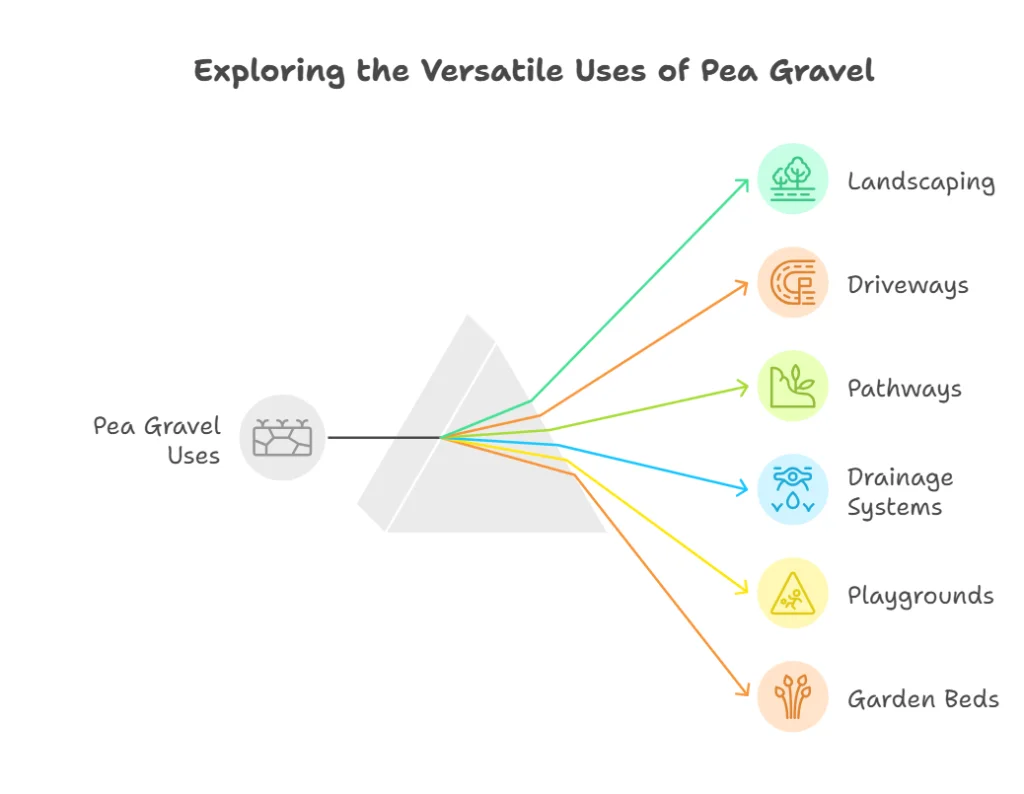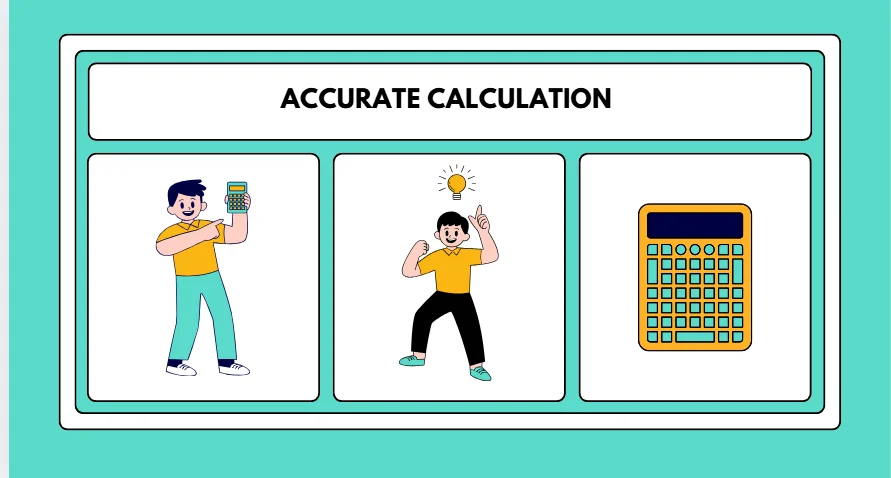Pea Gravel Calculator
Stop Guessing! Use Our Pea Gravel Calculator to Get Perfect Measurements Every Time.
Pea Gravel Online Calculator
Imagine walking through a beautiful garden, feeling the gentle crunch of smooth, round stones under your feet. That’s the magic of pea gravel! It’s not just any ordinary stone; it’s a special kind of gravel that looks great and feels even better. People use it to make their gardens, driveways, and pathways look super pretty and neat.
But here’s the thing: getting the right amount of pea gravel for your project can be a bit like solving a puzzle. You don’t want to buy too much and waste money, and you definitely don’t want to run out halfway through. That’s where our pea gravel calculator steps in like a superhero. It’s a super-smart tool that helps you figure out exactly how much pea gravel you need, so your project turns out just perfect.

In this guide, we’re going to take you on a fun adventure. We’ll explore everything you need to know about pea gravel, from what it is and why it’s so awesome, to how you can use our pea gravel calculator to make sure you get the right amount. We’ll also share some super-helpful tips to make your project a big success.
What is Pea Gravel?
Pea gravel is a type of small, smooth stone that looks like little peas. It’s usually about the size of a dime, ranging from 1/8 inch to 3/8 inch in diameter. This makes it perfect for walking on because it feels soft and gentle under your feet. Pea gravel comes in lots of natural colors, like gray, brown, and white, which makes it look really pretty in gardens and outdoor spaces.
Unlike some other types of gravel that are rough and jagged, pea gravel is smooth and round, so it doesn’t get stuck in your shoes or scratch your skin. It’s also great for letting water flow through, which helps keep your garden from getting too wet.
Uses of Pea Gravel
Pea gravel is a versatile and attractive material used in a variety of landscaping and construction projects. Its smooth texture and natural colors make it a popular choice for enhancing the beauty and functionality of outdoor spaces.

Here are some common uses of pea gravel:
- Landscaping: Adds a decorative touch to gardens and outdoor spaces.
- Driveways: Provides a stable surface when combined with a base layer.
- Pathways: Creates a comfortable walking surface.
- Drainage Systems: Allows water to flow through easily, preventing pooling.
- Playgrounds: Offers a soft and safe surface for children to play on.
- Garden Beds: Acts as a mulch to retain moisture and suppress weeds.
- Water Features: Enhances the appearance of ponds, fountains, and other water features.
- Patio Areas: Provides a natural and rustic look for outdoor living spaces.
- Erosion Control: Helps stabilize soil and prevent erosion in sloped areas.
- Decorative Accents: Used in flower beds, borders, and other decorative elements.
Pea gravel is a fantastic choice for anyone looking to enhance the beauty and functionality of their outdoor spaces. Its versatility and natural appeal make it a popular choice for a wide range of projects.

Why Use a Pea Gravel Calculator?
A pea gravel calculator eliminates guesswork by providing accurate measurements for your project. Here’s why it’s essential:
- Saves Money: Prevents over-ordering or under-ordering materials.
- Saves Time: Quickly calculates volume, weight, and cost.
- Improves Accuracy: Accounts for density, depth, and area shape.
How to Use the Pea Gravel Calculator
Using the calculator is simple. Follow these steps:
- Enter Dimensions: Input the length, width, and depth of the area.
- Select Area Shape: Choose from rectangle, circle, or triangle.
- Adjust Density: Use the default density or customize it based on your gravel type.
- Enter Price per Ton (Optional): Get an estimated cost for your project.
- Calculate Results: The tool will display the volume, weight, and cost of pea gravel needed.
Understanding Pea Gravel Density
Density is a critical factor in calculating the weight of pea gravel. The standard density for pea gravel is approximately 96 lbs/ft³. However, this can vary based on moisture content and stone size.
Pea Gravel Volume and Weight Calculation
- Volume Formula: Volume = Length × Width × Depth
- Weight Formula: Weight = Volume × Density
For example, if your area is 10 feet long, 5 feet wide, and 2 inches deep:
- Volume = 10 × 5 × (2/12) = 8.33 cubic feet
- Weight = 8.33 × 96 = 800 lbs
Pea Gravel Cost Estimation
The cost of pea gravel depends on:
- Volume: The amount of gravel needed.
- Density: Affects the total weight.
- Local Pricing: Prices vary by region and supplier.
Use the calculator to estimate costs by entering the price per ton or cubic yard.
Tips for Accurate Measurements
When it comes to measuring for pea gravel, precision is key to ensuring you get the right amount for your project. Here are some essential tips to help you measure accurately:
- Always double-check your dimensions before calculating. This simple step can save you from costly mistakes and ensure you order the correct amount of gravel.
- If your project area has uneven surfaces or slopes, adjust your depth measurements accordingly. This will help you account for variations in the terrain and ensure even coverage.
- It’s a good idea to order 5-10% more gravel than the calculator suggests. This extra gravel can cover any settling that occurs during installation and account for any spillage or uneven distribution.
Common Mistakes to Avoid
While using a pea gravel calculator can simplify the process, there are still some common mistakes to watch out for:
- A shallow layer of gravel may not provide adequate coverage, leading to an unfinished look or insufficient functionality. Make sure to measure the depth accurately and follow recommended guidelines for your specific project.
- Using the wrong density for your calculations can lead to incorrect weight estimates. Always use the correct density value for pea gravel to ensure accurate results.
- Guessing the amount of gravel you need can result in wasted time, money, and effort. Using a calculator ensures you get the right amount, saving you from overbuying or running short.
Environmental Impact of Pea Gravel
Pea gravel is not only a beautiful and functional choice for landscaping but also an eco-friendly option. It’s a natural material that requires minimal maintenance and has a long lifespan. Additionally, pea gravel promotes water drainage, reducing the risk of erosion and helping to keep your garden healthy. By choosing pea gravel, you’re making a sustainable choice that benefits both your outdoor space and the environment.
Choosing the Right Pea Gravel for Your Project
Selecting the right pea gravel for your project involves considering a few key factors:
- Size: The size of the gravel stones matters. Smaller stones are better for pathways and garden beds, providing a comfortable walking surface and a neat appearance. Larger stones are ideal for driveways, where durability and stability are more important.
- Color: Choose a color that complements your landscape design. Pea gravel comes in a variety of natural colors, so you can find one that matches your aesthetic preferences.
- Texture: The texture of the gravel affects its usability. Smooth stones are more comfortable for walking and less likely to cause discomfort or injury.
How to Install Pea Gravel
- Prepare the Area: Clear the site and level the ground.
- Add a Base Layer: Use crushed stone for stability.
- Spread the Gravel: Distribute evenly to the desired depth.
- Compact the Surface: Use a roller or tamper to secure the gravel.
FAQs About Pea Gravel Calculators
What is pea gravel?
Pea gravel is small, rounded stones used for landscaping and drainage.
How accurate is the calculator?
The calculator provides estimates based on your input. For precise results, consult a professional.Also use our gravel calculator.
Can I use the calculator for other materials?
Yes, but adjust the density to match the material.
How much extra pea gravel should I order?
Add 5-10% extra to account for settling and spillage.
What is the best depth for a driveway?
A depth of 4-6 inches is recommended for driveways.
If You Have Any Problem While Using This Calculator You can Contact Us Easily. We Are Here To Help You.
